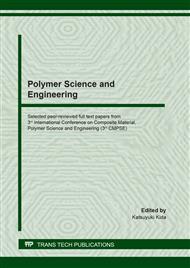[1]
X. Zhao, D.Kou, W. Zhou, Z. Zhou, Q. Meng, Z. Zheng, S. Wu,Nanoscale electrical property enhancement through antimony incorporation to pave the way for the development of low-temperature processed Cu2ZnSn(s,Se)4 solar cells, J.Mater.Chem. A. 7 (2019) 3135-3142.
DOI: 10.1039/c8ta11783g
Google Scholar
[2]
Z. Wang, H. Sun, Nanoscale in photocalysis, Nanomaterials (Basel). 7(4) (2017) 86.
Google Scholar
[3]
Y.S. Dzyazko, Y.M. Volfkovich, V. E. Sosenkin, N.F. Nikolskaya, Y.P. Gomza, Composite inorganic membranes containing nanoparticles of hydrated zirconium dioxide for electrodialytic separation, Nanoscale Res. Lett. 9 (2014) 271.
DOI: 10.1186/1556-276x-9-271
Google Scholar
[4]
D. Li, Y.Xia, Fabrication of titania nanofibers by electrospinning, Nano Lett. 2003, 3(4), 555-560.
DOI: 10.1021/nl034039o
Google Scholar
[5]
M. Wojashinski, M. Pilarek, T. Ciach, Comparative studies of electrospinning and solution blow spinning process for the production of nanofibrous poly(L-lactic acid ) materials for biomedical enginerring, Pol. J. Chem. Tech. 16 (2014) 2.
DOI: 10.2478/pjct-2014-0028
Google Scholar
[6]
E.S. Medeiros, G.M. Glenn, A. Klamczynski, W.J. Orts, L.H.C. Mattoso, Solution blow spinning: a new method to produce micro- and nanofibers from polymer solutions, J.Appl.Polym. Sci. 113 (2009) 4.
DOI: 10.1002/app.30275
Google Scholar
[7]
J.L. Daristotle, A.M. Behrens, A.D. Sandler, P.Kofinas, A review of the fundamental principles and applications of solution blow spinning, ACS Appl. Mater. Interfaces 8 (2016) 34951-34963.s.
DOI: 10.1021/acsami.6b12994
Google Scholar
[8]
Y. Polat, E.S. Pampal, E. Stonanovska, R. Simseek, A. Hassanin, A. Kilic, A. Demir, S. Yilmaz, Solution blowing of thermoplastic polyurethane nanofibers: afacile method to produce flexible porous materials, J. Appl. Polym. Sci. 133(2016) 43025.
DOI: 10.1002/app.43025
Google Scholar
[9]
H. Esfahani, R. Jose, S. Ramakrishna, Electospun ceramic nanofiber mats today: synthesis, properties, and applications, Materials 10(11) (2017) 1238.
DOI: 10.3390/ma10111238
Google Scholar
[10]
F.A. Sheik, J. Macossay, M.A. Kanjwal, A. abdal-hay, M.A. Tantry, H. Kim, Titanium dioxide nanofibers and microparticles containing nickel nanoparticles, ISRN Nanomater. 8 (2012) 816474.
DOI: 10.5402/2012/816474
Google Scholar
[11]
M. Blanco, et al., TiO2-doped electrospun nanofibrous membrane for photocatalytic water treatment, Polymers. 11(5) (2019) 747.
Google Scholar
[12]
S. NAsem, C-M. Wu, T-Z. Xu, C-C. Lai, S-P. Rwei, Oil-water separation of electrospun cellulose triacetate nanofiber membranes modified by electrophoretically deposited TiO2/graphene oxide, Polymers. 10(7) (2018) 746.
DOI: 10.3390/polym10070746
Google Scholar


